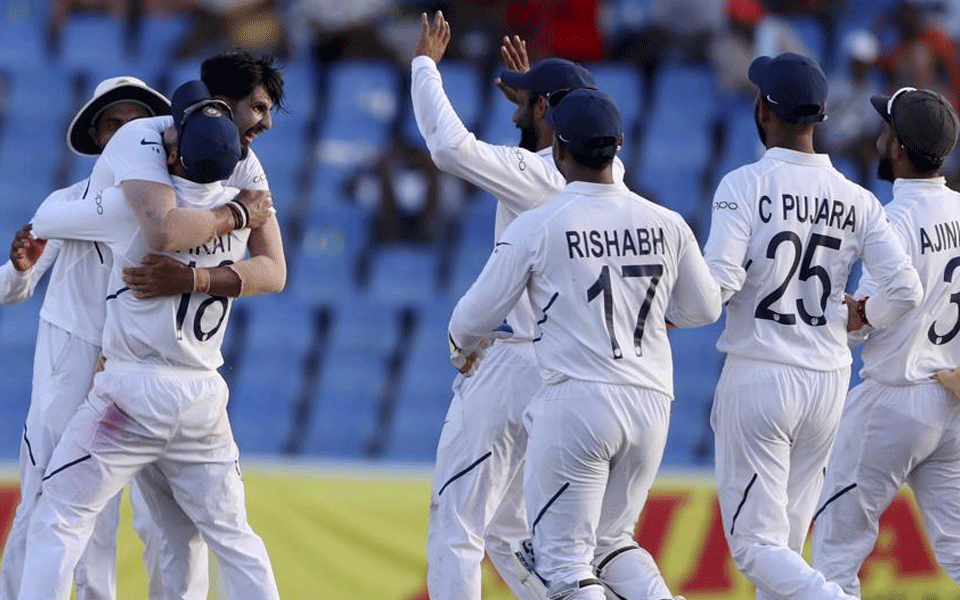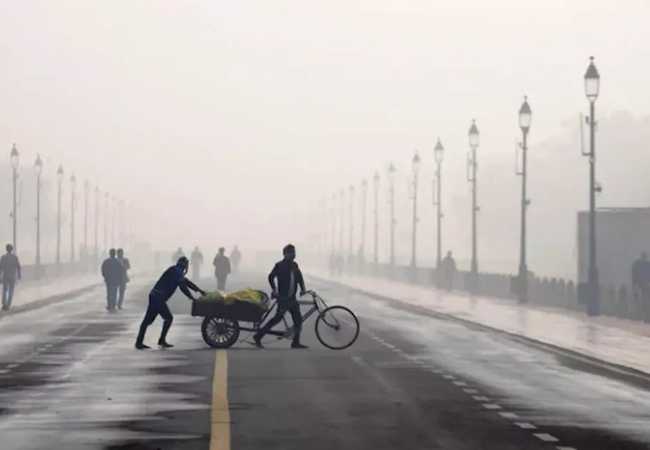North Sound (Antigua): Pacer Ishant Sharma's spirited effort and reckless batting from the West Indies helped India take control of the first Test on day two here on Friday.
The West Indies lost five wickets in the final session to be reeling at 189 for eight in their first innings at stumps, trailing India by 108 runs. Ishant Sharma took a five-wicket haul, his ninth in Tests, to put India in a strong position going into day three at Sir Vivian Richards Stadium.
India were helped by Roston Chase (48 off 47), John Campbell (23 off 30), Darren Bravo (18 off 27), Shai Hope (24 off 65) and Shimron Hetmyer (35 off 47) who were all guilty of throwing it away after promising starts.
India, who resumed the day at 203 for six, went on to make 297 courtesy a fighting 58 from Ravindra Jadeja who was ably supported by Ishant (19 off 62) during their 60-run stand for the eighth wicket.
The conditions were good for batting but the West Indies batsmen failed to apply themselves. Ishant made life difficult for them both with bat and ball. After frustrating the hosts in the morning session with his dogged stay in the middle, Ishant troubled the opposition with his incisive spells which included highly effective cross seam deliveries.
He was brilliant too with catching off his own bowling as he got two wickets in that fashion. At tea, the West Indies were struggling at 82 for three. After scoring a crucial half-century, Jadeja removed debutant Shamarh Brooks (11) to leave the home team at 50 for three.
The left-arm spinner had Brooks caught at first slip after his attempted cut ricocheted off Rishabh Pant's thigh to fall into the safe hands of Ajinkya Rahane.
With the pitch flattening out, there was not much movement off the pitch or in the air but Indian bowlers kept things tight to maintain pressure on the batsmen. The other West Indies batsmen to be dismissed were openers Kraigg Brathwaite (14) and Campbell, dismissed by Ishant and Mohammad Shami respectively.
In the morning, Jadeja and Ishant frustrated West Indies with a timely 60 run-stand for the eighth wicket, helping India reach 297 all out at the stroke of lunch.
Jadeja and Ishant were able to negotiate the threat posed by the potent pace duo of Shannon Gabriel (3/71) and Kemar Roach (4/66) after losing Rishabh Pant (24) in the second over of the day.
Jadeja's innings comprised six fours and a maximum before he became the last man to be dismissed in the Indian innings, leading to lunch. While Jadeja justified his inclusion in the playing XI ahead of Ravichandran Ashwin with a gritty effort, Pant could not deliver for the team.
Roach got his fourth wicket of the innings when he dismissed Pant with a beauty from around the wicket that moved away enough to get the edge of the young wicketkeeper-batsman.
Pant was guilty of playing the ball with hard hands as skipper Jason Holder took a regulation catch at second slip, leaving India at 207 for seven. It seemed India's brittle tail will not put up much of a fight yet again, but Jadeja and Ishant batted sensibly in their 116-ball stand, defying the West Indian pacers.
While maturity was expected from Jadeja, Ishant impressed with the way he dealt with the express pace of Roach and Gabriel. He was not afraid to come on to the front foot and was equally comfortable at tackling the rising ball.
The lanky India pacer, whose highest score is 31, was finally dismissed in the 90th over, playing on to a full slower ball off Gabriel. Shami joined Jadeja in the middle but his stay lasted only one ball as he offered a return catch to off-spinner Chase.
Running out of partners, Jadeja showed urgency to collect some vital runs and brought up his 11th half-century with a slap to cover for four. The following ball, he swept Chase for a six over deep midwicket, giving the Indian innings a welcome flourish towards the end.
Let the Truth be known. If you read VB and like VB, please be a VB Supporter and Help us deliver the Truth to one and all.
Hyderabad (PTI): The Telangana government on Sunday said it has decided to name the upcoming greenfield radial road at the proposed RRR in honour of the late industrialist Ratan Tata.
In another proposal, a high-profile road along the United States Consulate General in Hyderabad will be named ‘Donald Trump Avenue’, the government said in a release.
The state government will write to the Union Ministry of External Affairs and the US Embassy to inform them of the plans.
Earlier this year, Chief Minister A Revanth Reddy, while addressing the annual US-India Strategic Partnership Forum (USISPF) conclave in Delhi, had proposed naming key roads in Hyderabad after leading global corporations.
Additionally, a prominent stretch will be named ‘Google Street’ to recognise the global impact and contribution of Google and Google Maps.
The road along Google’s upcoming campus, set to be the company’s largest outside the US, in Hyderabad’s Financial District, will receive this recognition, the release said.
The proposals are part of the Telangana government’s initiative to position the state as a hub for innovation-driven development.
Microsoft and Wipro are also expected to receive recognition in the city’s topography, with a Wipro Junction and a Microsoft Road, in line with the chief minister’s vision, the release added.
The state government is considering dedicating additional roads in honour of distinguished individuals and corporations.





